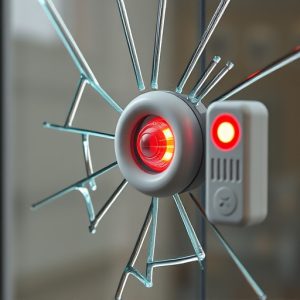Mastering Installation and Maintenance of Glass Break Alarm Sensors
Glass break alarm sensors are essential for detecting and preventing unauthorized entry and vandalis…….
Glass break alarm sensors are essential for detecting and preventing unauthorized entry and vandalism by identifying the sound of breaking glass. These devices are specifically tuned to recognize the unique frequency patterns of glass impact or fracture, effectively distinguishing them from other noises to minimize false alarms. Upon activation, they signal occupants or security personnel with an audible or visual alarm. Proper installation is critical for their effectiveness; sensors should be placed near windows or doors at a height and range that avoids interference from ambient noise and daily activities. Regular maintenance, including location assessment, sensor cleaning, sensitivity adjustment, monthly testing, battery upkeep, and software updates, ensures these systems remain accurate and reliable as a deterrent and early warning system for glass surface threats. By adhering to manufacturer guidelines and regularly checking the system, property owners can maintain a proactive security stance with glass break alarm sensors.
Securing your home or business against potential intruders is paramount, and a glass break alarm sensor stands as a formidable defense. This article delves into the intricacies of how these sensors operate and provides a detailed installation guide for your glass break alarm system. With insights into their mechanism and practical maintenance tips to optimize performance, enhance your property’s security with confidence using our comprehensive overview.
Understanding the Glass Break Alarm Sensor Mechanism
Glass break alarm sensors are pivotal components in securing properties against intrusion and vandalism. These sophisticated devices are engineered to detect the specific sound frequencies emitted by the impact or breakage of glass, distinguishing them from other sounds. Upon activation, they trigger an audible or visual alert, signaling the potential for unauthorized entry. The sensor operates on a microphone that captures the acoustic energy when glass is broken, analyzing it against pre-set frequency patterns that characterize glass breakage. This technology is advanced enough to discern between glass breaking and other loud noises, reducing false alarms while maintaining high sensitivity to genuine threats. The sensor’s mechanism involves a precise tuning to the resonant frequencies of glass, which are unique and identifiable when compromised. This ensures that the system responds appropriately to actual breaches, enhancing the security system’s reliability and effectiveness.
Proper installation of a glass break alarm sensor is critical for its optimal functionality. It involves placing the unit within a specific range of the glass to be monitored, ensuring its microphone can accurately capture the acoustic signature of glass breaking. The process typically begins with identifying the windows or doors that require protection and assessing their proximity to potential sources of ambient noise, which could interfere with the sensor’s performance. Installers must adhere to the manufacturer’s guidelines, positioning the sensor at a height that avoids interference from human voices or other common sounds, typically between four to six feet above the floor. Additionally, the sensor should be oriented away from windows or doors to prevent direct exposure to normal operational sounds, such as window air conditioners or closing of panels, which could trigger a false alarm. Through careful placement and calibration, these sensors can provide robust security against unauthorized access, serving as a deterrent and an alert system for glass break attempts.
Step-by-Step Guide to Installing a Glass Break Alarm System
To effectively install a glass break alarm system, it is imperative to follow a detailed and precise step-by-step guide. Begin by carefully selecting the optimal location for your glass break sensor within your home or establishment. Positioning is crucial as it should be near windows or doors where potential intrusions are most likely to occur. Once you’ve identified the best spots, adhere to the manufacturer’s instructions for mounting the sensors. Typically, this involves using screws to secure the sensor to the wall or window frame, ensuring it is at least four inches above the ground and in close proximity to the glass pane. After mounting, connect each sensor to the central control panel with the included wires. It’s essential to verify that all sensors are functioning correctly by performing a test activation to confirm that the alarm sounds when simulating the sound frequency of breaking glass. Finally, integrate the system with your existing security setup and program it according to the user manual’s guidance. Regularly test the entire system to ensure it operates as intended, providing a reliable layer of protection against potential break-ins.
After installation, routine maintenance is key to maintaining the effectiveness of your glass break alarm system. Periodically inspect the sensors for signs of wear or damage, and replace them as necessary. Keep the software updated to safeguard against evolving security threats. Additionally, consider consulting with a professional to ensure that all aspects of the system are properly calibrated and interconnected. By adhering to these installation and maintenance protocols, you can effectively secure your property with a glass break alarm sensor system that acts as a deterrent and an early warning system should an intrusion attempt occur.
Tips for Maintaining and Optimizing Your Glass Break Alarm Sensor's Performance
To maintain and optimize your glass break alarm sensor’s performance, it is crucial to adhere to a regular maintenance schedule. Begin by ensuring that the sensor is installed in a location where it can detect sounds from all potential points of glass breakage without interference from ambient noise or obstructions. Clean the sensor periodically using a soft, dry cloth to remove dust and fingerprints that could potentially muffle sound detection. Verify that the sensitivity settings are appropriate for your environment, as a sensitivity too high might result in false alarms, while a setting too low could miss actual breakage events. Test the system monthly by simulating a glass break to confirm its responsiveness. Additionally, keep the sensor’s battery charged or replaced according to the manufacturer’s guidelines to prevent unexpected downtime during an emergency. Regularly update your alarm system’s firmware and software to benefit from the latest improvements and bug fixes, which can enhance detection accuracy and overall system reliability. By following these maintenance practices, you can ensure that your glass break alarm sensor remains a vigilant protector of your property.


